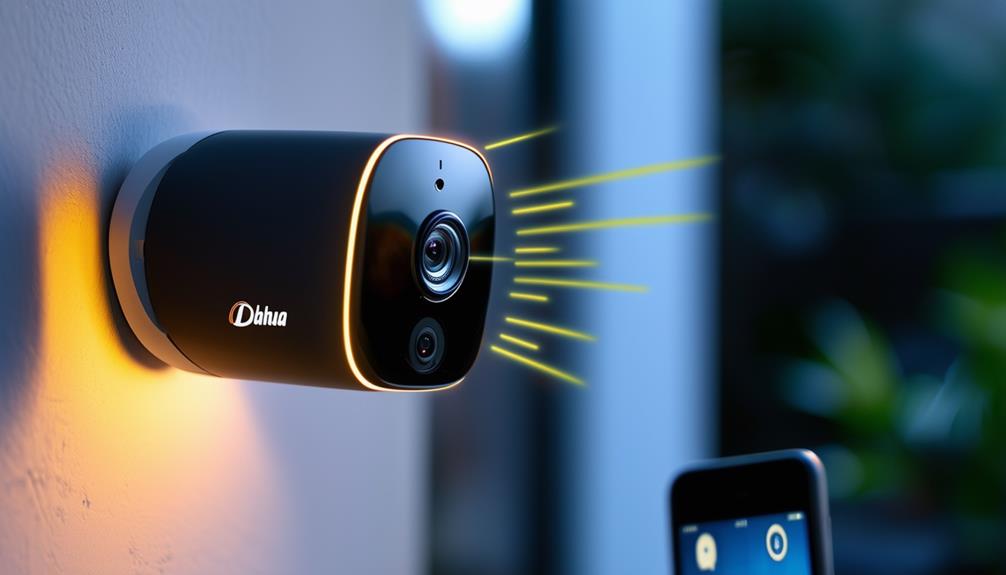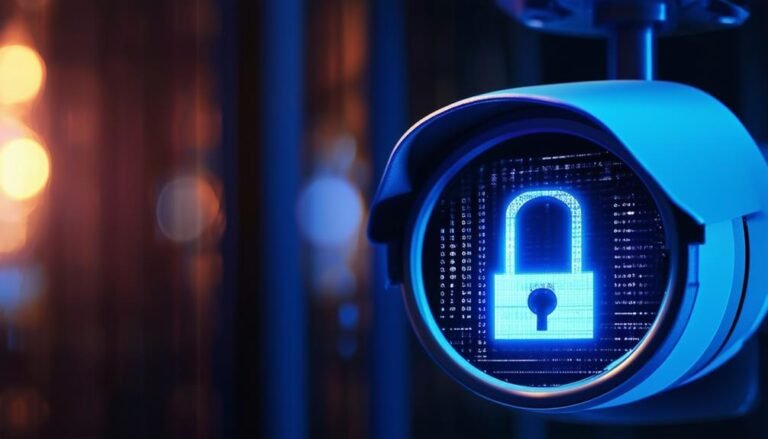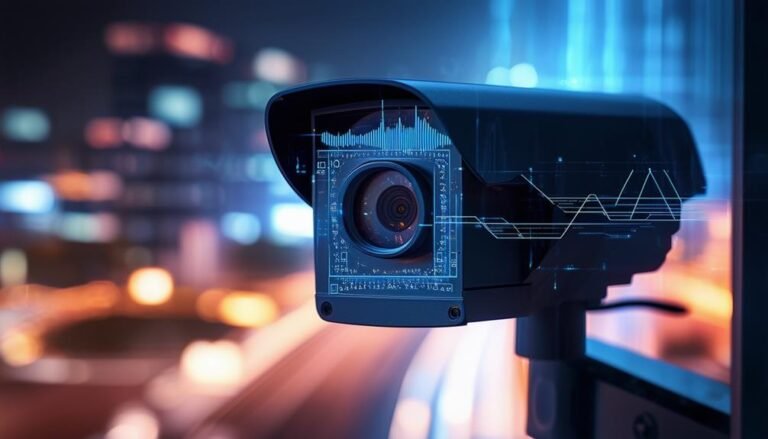To connect your Dahua camera to WiFi, start by making sure you have a reliable network and the camera is plugged in. Next, connect your computer or smartphone to the same network as the camera. Open a web browser and enter the camera’s IP address, using “admin” for both username and password to log in. Locate the Wi-Fi settings, choose your network, and enter the password. Save your settings and wait for the connection. Once it’s connected, you can test the live feed. You’ll find more tips on optimizing your camera’s performance as you explore further.
Gather Required Equipment
Before you get started with connecting your Dahua camera to WiFi, you’ll need a few fundamental items. First off, make sure you have a reliable WiFi network in your home or office. This is vital because your camera needs to communicate seamlessly with your network for best performance. If you’ve got a router, make sure it’s working properly and within range of where you plan to install the camera.
Next, grab the Dahua camera itself, along with its power adapter and any cables that came with it. You’ll want to have these on hand to make the setup process smoother. Don’t forget to check the camera’s model number, as some features might vary between models, which could affect the connection process.
Additionally, it’s wise to have a smartphone or computer ready for configuration. You’ll use this device to access the camera’s settings and connect it to your WiFi. If you’ve got the Dahua app installed on your smartphone, that’ll make things even easier.
Lastly, a stable internet connection is necessary. A weak signal could lead to connectivity issues, which can be frustrating. If you’ve got a WiFi extender, consider using it to boost the signal in the camera’s location.
With all these items gathered, you’re one step closer to enjoying the freedom of surveillance that a Dahua camera offers. So, let’s get ready to connect!
Power On the Camera
To kick off the installation process, you’ll need to power on your Dahua camera. This step is essential for guaranteeing that you can set up the device and connect it to your Wi-Fi network. Here’s what you should do to get started:
- Find a Suitable Power Source: Make sure you have access to an electrical outlet nearby. Depending on your camera model, you might need a power adapter or a PoE (Power over Ethernet) connection.
- Connect the Power Supply: If your camera uses a power adapter, plug it into the camera’s power input. For PoE cameras, connect the Ethernet cable to a PoE switch or injector, which will provide both data and power.
- Check Indicator Lights: Once powered, observe the LED indicator lights on your camera. They should illuminate, indicating that the camera is receiving power. If the lights don’t turn on, double-check your connections to verify everything’s secure.
Access the Camera Interface
Now that your Dahua camera is powered on, the next step involves accessing the camera interface. This is where you’ll gain control over your camera’s settings and features, allowing you to customize it to fit your needs. To start, connect your computer or smartphone to the same network that your camera is on. You can do this via Wi-Fi or an Ethernet cable, depending on your preference.
Once you’re connected, open a web browser and enter the camera’s IP address in the address bar. If you’re unsure of the IP address, you can often find it in the camera’s manual or by using software that scans your network for connected devices. After entering the IP address, hit Enter. You should be greeted by the camera’s login page.
Here, you’ll enter your username and password. If you haven’t changed these from the factory settings, they’re likely something simple like “admin” for both fields. But for security’s sake, it’s wise to change the default login credentials once you’re in.
After logging in, you’ll have access to the camera interface. This interface typically features various tabs for configuration settings, live view options, and playback controls. Take a moment to explore what’s available; familiarizing yourself with the layout will empower you to manage your camera effectively. Enjoy the freedom of customizing your surveillance experience to suit your lifestyle!
Configure Wi-Fi Settings
Configuring your Wi-Fi settings is essential for ensuring your Dahua camera connects seamlessly to your network. A solid connection gives you the freedom to monitor your space from anywhere, and it’s straightforward once you know what to do. Here’s a quick checklist to guide you through:
- Access the Wi-Fi Settings: Navigate to the camera’s interface and find the Wi-Fi settings section. This is usually under the “Network” or “Wireless” options.
- Select Your Network: You’ll see a list of available networks. Choose your Wi-Fi network from the list. Make sure you select the right one to avoid any connectivity issues.
- Enter Your Password: After selecting your network, you’ll need to input the Wi-Fi password. Make sure you type it correctly, as even a small mistake can prevent your camera from connecting.
Once you’ve gone through these steps, save your settings and wait for the camera to establish a connection. It might take a moment, but once it’s connected, you’ll have the freedom to access your camera feeds wirelessly.
Test the Connection
After you’ve configured your Dahua camera’s Wi-Fi settings, it’s important to test the connection to verify everything is working smoothly. You want to guarantee that your camera can communicate with your network effectively. Start by accessing the camera’s live feed through the Dahua app or web interface. If you see the feed without any interruptions, congratulations, your connection is likely solid!
However, if you encounter issues, don’t worry. You can troubleshoot by checking a few key elements. Below is a quick checklist that may help you pinpoint the problem:
| Step | Action |
|---|---|
| Check Wi-Fi Signal | Confirm your camera is within range of the Wi-Fi router. |
| Reboot Camera | Power cycle your camera to refresh the connection. |
| Verify Credentials | Double-check the Wi-Fi password entered in the settings. |
| Update Firmware | Make sure your camera’s firmware is up-to-date for peak performance. |
Testing the connection can save you from potential headaches down the road. If everything’s working well, you should have the freedom to monitor your surroundings without any hassle. If problems persist, consider reaching out to Dahua support or checking online forums for additional help. Remember, the goal is to achieve a stable connection that gives you peace of mind.
Monitor Your Camera Online
Once you’ve confirmed that your Dahua camera is connected to Wi-Fi, you can easily monitor it online. This gives you the freedom to check on your property from anywhere. Whether you’re at work, on vacation, or just lounging at home, keeping an eye on things has never been easier. Here are a few steps to get you started:
- Download the App: Get the Dahua app from your device’s app store. It’s user-friendly and designed for remote access.
- Log In: Use your camera’s credentials to log into the app. If you’ve set up an account, simply enter your details.
- Access Live Feed: Once logged in, you can access the live feed of your camera. This is where you’ll see real-time footage of your surroundings.
With these steps, you’ll have peace of mind knowing you can monitor your camera anytime, anywhere. The app not only allows you to view live footage but also offers features like motion alerts and playback options. Imagine being able to check in on your home while you’re out exploring the world or simply relaxing at a café.
Frequently Asked Questions
What Are the Default Login Credentials for Dahua Cameras?
When you’re opening the door to your Dahua camera, you’ll find the default credentials waiting like a key on a hook. Typically, the username is “admin” and the password is either “admin” or left blank. It’s like stepping into a secret garden where you’re free to explore. Just remember, for your security, it’s wise to change those defaults soon after entering. Your camera’s potential is in your hands!
Can I Connect Multiple Dahua Cameras to the Same Wi-Fi Network?
Yes, you can connect multiple Dahua cameras to the same Wi-Fi network. It’s a great way to expand your surveillance coverage without the hassle of additional hardware. Just make sure that your router can handle the number of devices you’re connecting. Each camera will need to be set up individually, but once they’re connected, you’ll have a cohesive system that gives you peace of mind and freedom to monitor your space effectively.
How Can I Reset My Dahua Camera to Factory Settings?
To reset your Dahua camera to factory settings, first, find the reset button on the device. Press and hold this button for about 10 seconds until you see the indicator light flash, signaling the reset process. Once done, the camera will revert to its original settings. You can then reconfigure it as needed. Remember, this process will erase all previous configurations, so make sure you’re ready for a fresh start!
What Should I Do if My Camera Can’t Find the Wi-Fi Network?
Imagine a bird trying to spread its wings but finding a cage instead. If your camera can’t find the Wi-Fi network, check if the signal’s strong enough, like sunlight filtering through leaves. Confirm your camera’s within range and the network’s not hidden. Restart both your camera and router; sometimes, they just need a moment to reconnect. If all else fails, consider adjusting the settings or updating the firmware for that extra freedom.
Are There Any Compatibility Issues With Different Wi-Fi Routers?
When using different Wi-Fi routers, you might encounter compatibility issues. Not all routers support every device, so it’s essential to check if your router’s frequency and encryption settings match your camera’s requirements. Some cameras only work with 2.4 GHz networks, while others may struggle with certain security protocols. If you’re facing connectivity problems, consider updating your router’s firmware or trying a different router to guarantee smoother communication with your camera.



